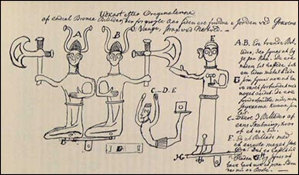Top Qs
Timeline
Chat
Perspective
Grevensvænge figurines
From Wikipedia, the free encyclopedia
Remove ads


The Grevensvænge hoard is a find of the late Nordic Bronze Age (roughly dating to between 800 BC and 500 BC), discovered in the late 18th century at Grevensvænge, Næstved Municipality, Zealand, Denmark. The hoard consisted of seven bronze figurines. Its first mention is in 1779, where it is said to have been found in the ground "a few years ago". After their discovery, they were kept with the pastor at Herlufmagle, Marcus Schnabel.
A drawing of four of the figurines was made in 1779, by Schnabel. The drawing shows two kneeling figures of warriors with horned helmets and axes, a leaping acrobat, and a standing woman. The shape of the rest is unknown, said to have been sold at aution in 1800.[1] Five of these figurines are now lost, while two were bought by the Danish National Museum in 1823 and 1839. The right axeman is pressumed lost during the Bombardment of Kopenhagen in 1807.
Based on comparison with petroglyphs of the same era (e.g. Tanumshede, Sweden), it is assumed that the figurines were originally part of an ensemble arranged on a ship.
Both the twins motif and the cultic significance of the horned helmets, seems to have persisted into early Germanic culture. The kneeling warrior figures have been interpreted as the "Ashvins" type divine twins of early Indo-European religion, sons of the sky-god, known by the name of Alcis to Tacitus.
Remove ads
See also
- Veksø helmets, Bronze Age helmets from Denmark, with similar horned design
- Religion of Bronze Age Europe
- Solar barge
- Trundholm sun chariot
References
Further reading
External links
Wikiwand - on
Seamless Wikipedia browsing. On steroids.
Remove ads
